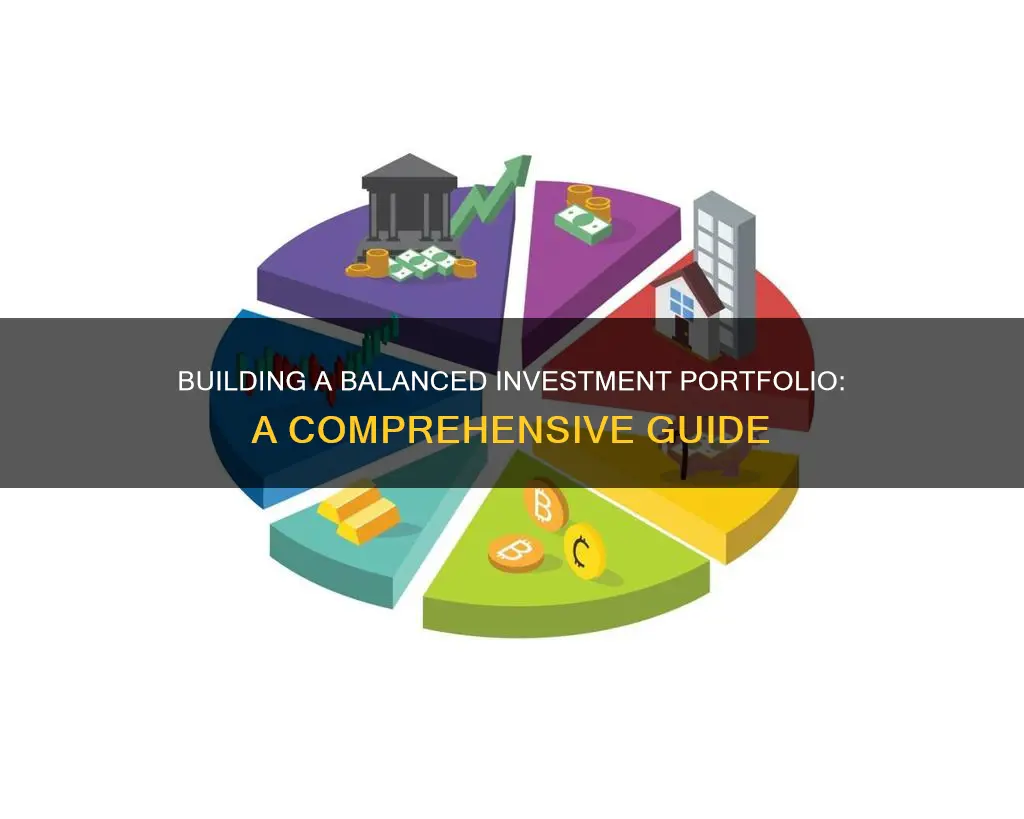
A balanced investment portfolio is a combination of cash, bonds, and stocks that help manage risk and maximise return potential. The portfolio is determined by an investor's goals, investment horizon, need for capital, and tolerance for risk. While there is no one-size-fits-all approach, a balanced portfolio generally consists of a diverse mix of assets, including stocks, bonds, cash, and real estate. The mix may vary depending on an individual's financial situation, risk tolerance, age, and investment goals. For example, a younger investor with a higher risk tolerance may opt for a portfolio with a larger percentage of stocks, while an older investor may prefer a more conservative approach with a higher percentage of bonds or cash. Ultimately, the goal of a balanced investment portfolio is to generate returns while managing risk.
| Characteristics | Values |
|---|---|
| Risk tolerance | Moderate |
| Investment strategy | Mix of stocks, bonds, and cash |
| Investment goals | Long-term, retirement |
| Investment horizon | Mid- to long-range |
| Investor age | 30s, 40s, 50s, retirement |
| Investor circumstances | Newly married, starting a family, retired |
| Asset allocation | 50/50 or 60/40 split between stocks and bonds |
| Diversification | Divide money among asset classes to reduce risk |
| Rebalancing | Yearly or after significant life events |
| Liquidity | Small cash or money market component |
| Investment returns | Modest |
| Capital preservation | High |
| Volatility | Low |

Stocks, bonds, and cash
A balanced investment portfolio is one that combines asset classes to balance risk and return. While there is no one-size-fits-all formula, a balanced portfolio will typically include stocks, bonds, and cash or cash equivalents in varying percentages.
Stocks
Stocks, also known as equities, are a type of security that represents ownership in a company. When you buy stock, you're purchasing a small piece of that company, and you become a shareholder. This means you're entitled to a share of the company's profits, usually in the form of dividends. Stocks are often considered riskier than bonds, but they also have the potential for higher returns. The percentage of stocks in a balanced portfolio can vary depending on the investor's risk tolerance and financial goals. For example, a more aggressive investor with a high-risk tolerance may have a majority of their portfolio invested in stocks, while a conservative investor may opt for a lower percentage.
Bonds
Bonds are a type of security that represents a loan made by an investor to a company or government. When you buy a bond, you're essentially lending money to the issuer, who agrees to pay you back the principal amount (the amount borrowed) plus interest over time. Bonds are generally considered safer than stocks, but they tend to generate lower returns. Bonds can be an important tool for offsetting the risks of stock volatility in a portfolio.
Cash
Cash and cash equivalents, such as savings accounts, money market funds, and certificates of deposit (CDs), are the lowest-risk and most liquid asset class. They are easily accessible and designed to protect your capital, meaning you're unlikely to incur significant losses. Cash can provide liquidity, portfolio stability, and emergency funds. It's important to note that cash has historically not kept up with rising prices, and it may not be able to achieve long-term investing goals in the same way that stocks and bonds can. The percentage of cash in a portfolio should be guided by the investor's financial goals, risk tolerance, and time horizon. A common rule of thumb is to have between 2% and 10% of your portfolio in cash and cash equivalents.
Building a Balanced Portfolio
When building a balanced portfolio, it's essential to consider your financial goals, investment horizon, need for capital, and tolerance for risk. Diversification is also key—spreading your investments across different asset classes, sectors, and geographic regions can help reduce risk. Additionally, it's important to regularly monitor and rebalance your portfolio to ensure it remains aligned with your financial objectives.
Investment Philosophy: Portfolio Diversification Strategies Explained
You may want to see also

Risk tolerance
An individual's risk tolerance is influenced by various factors, including age, financial situation, investment goals, and personality. Younger investors, for example, often have a higher risk tolerance as they have a longer time horizon for their investments to recover from potential downturns. They can afford to take more significant risks in pursuit of higher returns. On the other hand, older investors approaching retirement typically have a lower risk tolerance and seek to preserve their wealth, opting for more stable and predictable investments.
When assessing risk tolerance, it is important to consider both the objective and subjective aspects. Objectively, factors such as net worth, income, and financial obligations play a role in determining how much risk one can objectively bear. Subjectively, an individual's risk tolerance is influenced by their personality, investment experience, and emotional response to market volatility. Some people are naturally more comfortable with risk and volatility, while others prefer a more conservative approach to protect their capital.
To determine one's risk tolerance, it is advisable to work with a financial professional who can help assess these factors and develop an investment strategy that aligns with the investor's comfort level. Risk tolerance questionnaires and tools are also available to help individuals understand their risk tolerance better. These tools often consider factors such as age, investment horizon, financial goals, and emotional response to market fluctuations.
Once an investor's risk tolerance is established, it guides the selection of asset classes and the allocation of investments within their portfolio. For example, investors with a higher risk tolerance may allocate a larger portion of their portfolio to stocks, including growth stocks and small-cap companies, which offer the potential for higher returns but come with greater risk. On the other hand, investors with a lower risk tolerance may favour a larger allocation of bonds, cash, and investment-grade securities, which are generally considered lower-risk investments.
It is important to note that risk tolerance can change over time as an individual's financial situation, goals, and life circumstances evolve. Therefore, it is advisable to periodically reassess one's risk tolerance and make adjustments to the investment portfolio as needed to ensure it remains aligned with the investor's comfort level and objectives.
Creating Your First Investment Portfolio: A Beginner's Guide
You may want to see also

Asset allocation
The allocation of assets in your portfolio is influenced by various factors, including your goals, investment horizon, need for capital, and tolerance for risk. For example, if you're investing for retirement, you need to consider when you plan to retire and how much money you'll need. Your risk tolerance is another critical factor. Conservative investors with a low-risk tolerance tend to favour lower-risk assets like bonds and cash, while aggressive investors willing to take on more risk for higher returns typically invest a larger proportion of their money in stocks.
To build a balanced portfolio, you should first determine your financial goals, investment timeframe, and risk tolerance. Then, select the appropriate asset classes and investments within those classes. For instance, if you're investing for retirement at a younger age, you might opt for a larger allocation of stocks due to their higher growth potential. On the other hand, if you're closer to retirement, you may prefer a heavier weighting of bonds or money market assets for lower risk.
It's important to diversify your portfolio across different asset classes and within each class. For example, if you allocate 60% of your portfolio to stocks, you can further diversify by including foreign and domestic stocks of varying market capitalisations. Similarly, you can diversify your bond investments by term and type, such as government and corporate bonds. Mutual funds, exchange-traded funds (ETFs), and index funds are also useful tools for diversification, as they typically invest in multiple securities, reducing the overall risk.
Lastly, remember that a balanced portfolio requires regular rebalancing. Financial markets fluctuate, and your life circumstances can change, so it's important to monitor your portfolio and adjust your investments accordingly. This might involve selling some of your best-performing assets or investing new funds into underperforming assets to restore your desired balance.
Investing vs Saving: Understanding the Key Differences
You may want to see also

Diversification
One easy way to create a diversified portfolio is to invest in mutual funds, exchange-traded funds, or index funds, as these are invested in multiple securities rather than individual stocks, thereby reducing risk. Another option is to select a lifecycle fund, such as a retirement fund.
It's important to note that diversification should be tailored to your financial situation, goals, time frame, and risk tolerance. For example, if you're in your 20s, you may be more willing to invest a larger percentage of your assets in stocks due to their higher growth potential. As you get older, you may want to shift your asset allocation towards more conservative investments, such as bonds or money market accounts, which offer less risk.
Additionally, it's crucial to regularly rebalance your portfolio, as the value of investments can fluctuate over time. This involves evaluating the percentage each asset class comprises of your entire portfolio and making adjustments as needed. For example, if you have too much weight in one asset class, you may want to sell some of those investments and invest the proceeds in another underweighted asset class.
Young Savers: Investing for the Future Now
You may want to see also

Rebalancing
Even with a well-balanced portfolio, it is important to remember that the value of investments can change over time. Therefore, it is crucial to regularly rebalance your portfolio to ensure it stays aligned with your goals, risk tolerance, and time horizon. This process involves evaluating the percentage each asset class comprises of your entire portfolio and making adjustments as necessary. For example, if you find that one asset class has grown to make up a much larger percentage of your portfolio than intended, you may want to sell some of those investments and invest the proceeds in an underweighted category.
It is recommended to rebalance your portfolio at least annually or after significant life events such as a career change, marriage, or the birth of a child. However, it is important to keep in mind that rebalancing may involve selling some of your best-performing assets in favour of lesser-performing ones. To avoid this, another approach is to invest new funds into the underweighted assets instead.
Additionally, reevaluating your portfolio balance yearly allows you to account for any changes in your goals and investment strategies. For instance, you may want to take on more risk at certain phases of your life and adopt a more conservative approach at other times.
Savings and Investment: Finding Equilibrium Balance
You may want to see also
Frequently asked questions
A balanced investment portfolio is a combination of cash, bonds, and stocks that help manage risk and maximise return potential. It is important to note that there is no one-size-fits-all approach to a balanced portfolio, as it depends on an individual's financial situation, goals, risk tolerance, and investment horizon.
A balanced investment portfolio helps to manage market risk and achieve long-term goals. It also allows individuals to balance risk and return, preserving capital while seeking modest growth.
To create a balanced investment portfolio, individuals should first assess their financial goals, investment horizon, risk tolerance, and need for capital. Based on these factors, they can then determine their asset allocation, choosing from various asset classes such as stocks, bonds, cash, real estate, and commodities. Diversification across and within asset classes is key to reducing risk and maximising returns.
It is recommended to review and rebalance your portfolio at least annually or after significant life events, such as a career change, marriage, or the birth of a child. This ensures that your investments remain aligned with your risk tolerance, investment goals, and time horizon.
Common strategies include fixed income, income, balanced, growth, and yield approaches. Fixed income strategies focus on capital preservation and are suitable for conservative investors. Income strategies prioritise income generation and may include dividend-paying stocks and coupon-yielding bonds. Balanced strategies aim for a mix of income and capital appreciation, typically investing in a combination of stocks and bonds. Growth strategies seek capital appreciation and primarily invest in stocks. Finally, yield strategies target higher returns by taking on more risk, including high-growth stocks or alternative investments.







